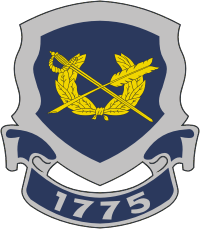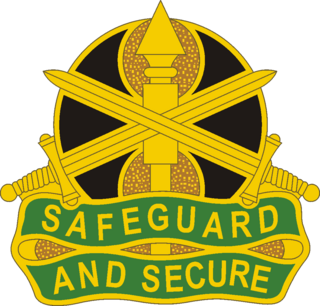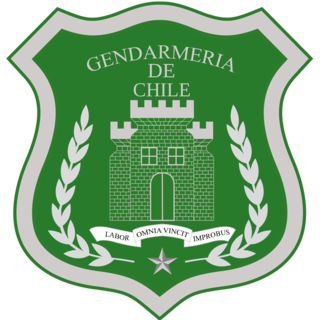The Meritorious Unit Commendation is a mid-level unit award of the United States Armed Forces. The U.S. Army awards units the Army MUC for exceptionally meritorious conduct in performance of outstanding achievement or service in combat or non-combat, the U.S. Navy and U.S. Marine Corps award units the Navy MUC for valorous or meritorious achievement or service in combat or non-combat, and the U.S. Coast Guard awards units the Coast Guard MUC for valorous or meritorious achievement or service not involving combat.

A cap badge, also known as head badge or hat badge, is a badge worn on uniform headgear and distinguishes the wearer's nationality and/or organisation. The wearing of cap badges is a convention commonly found among military and police forces, as well as uniformed civilian groups such as the Boy Scouts, civil defence organisations, ambulance services, customs services, fire services etc.

The United States Penitentiary, Administrative Maximum Facility, commonly known as ADX Florence or The Florence Supermax, is an American federal prison in Fremont County near Florence, Colorado, operated by the Federal Bureau of Prisons, a division of the United States Department of Justice. ADX Florence, constructed in 1994 and opened one year later, is classed as a supermax or "control unit" prison, that provides a higher, more controlled level of custody than a maximum security prison. ADX Florence forms part of the Federal Correctional Complex, Florence, which is situated on 49 acres of land and houses different facilities with varying degrees of security, including the adjacent United States Penitentiary, Florence High.

The Republican Guard Brigade, also known as the Presidential Guard Brigade, is a unit of the Land Component of the Lebanese Armed Forces (LAF), attached to the Directorate-General of the Presidency of Lebanon.

The Judge Advocate General's Corps of the United States Army, also known as the U.S. Army JAG Corps, is the legal arm of the United States Army. It is composed of Army officers who are also lawyers and who provide legal services to the Army at all levels of command, and also includes legal administrator warrant officers, paralegal noncommissioned officers and junior enlisted personnel, and civilian employees.

EKO Cobra is the police tactical unit of the Austrian Federal Ministry of the Interior. EKO Cobra is not part of the Austrian Federal Police, but instead is directly under the control of the Federal Ministry of the Interior.

A prison officer (PO) or corrections officer (CO), also known as a correctional law enforcement officer or less formally as a prison guard, is a uniformed law enforcement official responsible for the custody, supervision, safety, and regulation of prisoners. They are responsible for the security of the facility and its property as well as other law enforcement functions. Most prison officers or corrections officers are employed by the government of the jurisdiction in which they operate, although some are employed by private companies that provide prison services to the government.

The Israel Prison Service, known in Israel by its acronym Shabas or IPS in English, is the state agency responsible for overseeing prisons in Israel. It is under the jurisdiction of the Ministry of Public Security. In 2014, its workforce was 8,800.

The Polícia de Segurança PúblicaMHTE is the national civil police force of Portugal. Part of the Portuguese security forces, the mission of the PSP is to defend Republican democracy, safeguarding internal security and the rights of its citizens. Despite many other functions, the force is generally known for policing urban areas with uniformed police officers, while rural areas are normally policed by National Republican Guard (GNR), the country's national gendarmerie force. PSP is focused in preventive policing, only investigating minor crimes. Investigation of serious crimes falls under the Judicial Police responsibility, which is a separate agency.

A correctional emergency response team is a team of specially trained prison officers tasked with responding to disturbances, riots, cell extractions, mass searches, and other situations in prisons that are likely to involve uncooperative or violent prisoners.

Provosts are military police (MP) whose duties are policing solely within the armed forces of a country, as opposed to gendarmerie duties in the civilian population. However, many countries use their gendarmerie for provost duties.
Law enforcement in Spain is carried out by numerous organizations, not all of which operate in the same areas.
The "trusty system" was a penitentiary system of discipline and security enforced in parts of the United States until the 1980s, in which designated inmates were given various privileges, abilities, and responsibilities not available to all inmates.

The 785th Military Police Battalion (I/R) is an Army Reserve unit whose mission is to provide command, planning, administration, and logistical support for the operation of an internment/resettlement facility. It is located in Fraser, Michigan.
Corrective Services New South Wales (CSNSW) is a division of the Department of Communities and Justice of the Government of New South Wales, Australia. CSNSW is responsible for the state's prisons and a range of programs for managing offenders in the community. The state has 36 prisons, 33 run by CSNSW and three privately operated. The agency traces its origins back to 1788, when New South Wales was founded as a penal colony.

The Department of Public Safety and Corrections (DPS&C) is a state law enforcement agency responsible for the incarceration of inmates and management of facilities at state prisons within the state of Louisiana. The agency is headquartered in Baton Rouge. The agency comprises two major areas: Public Safety Services and Corrections Services. The secretary, who is appointed by the governor of Louisiana, serves as the department's chief executive officer. The Corrections Services deputy secretary, undersecretary, and assistant secretaries for the Office of Adult Services and the Office of Youth Development report directly to the secretary. Headquarters administration consists of centralized divisions that support the management and operations of the adult and juvenile institutions, adult and juvenile probation and parole district offices, and all other services provided by the department.

The State Correctional Institution (SCI) at Camp Hill, commonly referred to as SCI Camp Hill, is a Pennsylvania Department of Corrections prison in Lower Allen Township, Cumberland County, near Camp Hill in Greater Harrisburg. Its current superintendent is Laurel Harry. It has around 3,400 inmates.

The Federal Penitentiary Service is a federal agency of the Ministry of Justice of Russia responsible for correctional services.

The Chilean Gendarmerie, is the title of Chile's uniformed national prison service military. The service evolved when Chilean Army units were given police and prison duties under president Carlos Ibáñez del Campo, a move that also created the Carabineros de Chile police force.

















